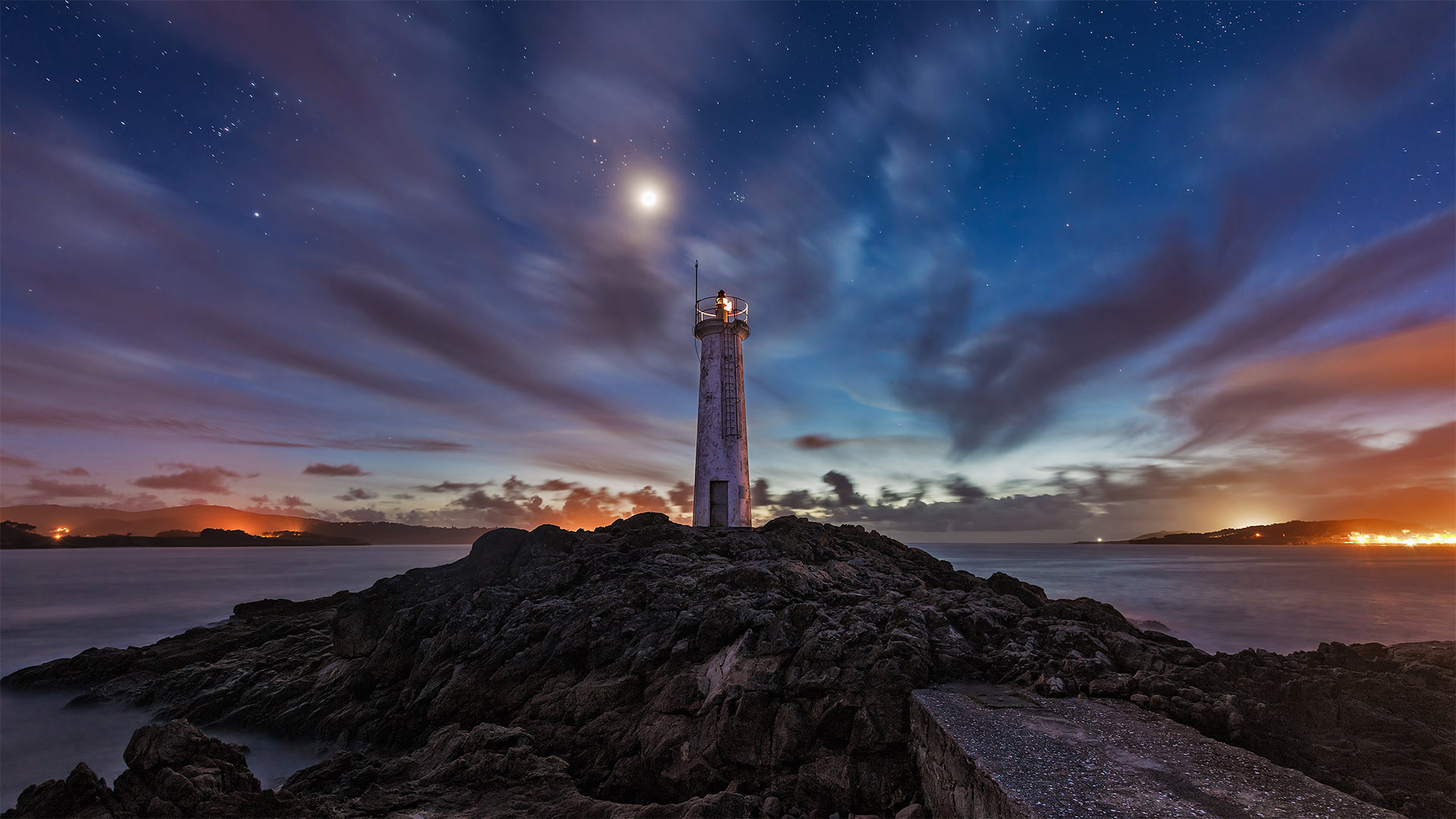加利西亚省科斯塔达莫尔特的灯塔,西班牙 Faro de Playa Lago, Costa da Morte, Muxia, Galicia, Spain (© Carlos Fernandez/Getty Images)

加利西亚省科斯塔达莫尔特的灯塔,西班牙 Faro de Playa Lago, Costa da Morte, Muxia, Galicia, Spain (© Carlos Fernandez/Getty Images)
死亡海岸 The Coast of Death
International Lighthouse Day
This solemn beacon set atop a rocky outcropping is in a country usually associated with sand and sun, making this a side of Spain many do not often see. We're looking out at the sea on the Costa da Morte, or Coast of Death, a nasty name for an equally nasty (but beautiful!) stretch of Galician coastline in the extreme northwest of Spain. We're featuring Costa da Morte on International Lighthouse Day because mariners are never happier to see a lighthouse than when they're sailing this coast, known as the Bermuda Triangle of the Eastern Atlantic.
The Costa da Morte is known for its lighthouses, like this one, called Faro de Playa Lago, one of many strung along 125 miles of coast from Finisterre in the south to Malpica in the north. As a devourer of ships, the Costa da Morte is prolific. Since the 14th century, more than 600 shipwrecks have been documented resulting in the loss of thousands of lives. This corner of Spain lies at the southern end of the Bay of Biscay, also known for its rough waters. The rocky Costa da Morte faces the open North Atlantic and takes the brunt of big ocean swells. (The famous big-wave surf break at Nazare, Portugal, is only a few hundred miles to the south.) Deep waters turn to shallow waters quickly near this rocky cliff-strewn coast, known for its strong currents and hidden rocks. The fog can roll in quickly. Storms form frequently. And hurricane-force winds are not uncommon.
Cool, rainy, and rocky, the Galicia region of Spain is more 'Lord of the Rings' than Club Med. Hiking along this coast, you might feel like you're Scotland rather than Spain, and is compounded by the fact that Galicians themselves are considered a Celtic ethnic group. To visit the lighthouses of Costa da Morte, you can walk a trail appropriately called Camino dos Faros (Road of the Lighthouses). While satellite technology and electronic instruments vastly changed how safely we can now navigate the seas, lighthouses are still vital to boating and the maritime industry. Plus, they're just darn good-looking.
国际灯塔日
这座庄严的灯塔矗立在岩石露头上,位于一个通常与沙子和太阳联系在一起的国家,这使它成为许多人不常看到的西班牙的一面。我们看到的是死亡海岸(Costa da Morte)上的大海,这是一个同样令人讨厌的名字(但很漂亮!)西班牙西北端的加利西亚海岸线。我们在国际灯塔日特别报道科斯塔·达·莫特,因为水手们在这个被称为东大西洋百慕大三角的海岸航行时,看到灯塔最开心。
Costa da Morte以其灯塔而闻名,比如这座被称为Faro de Playa Lago的灯塔,它是从南部的菲尼斯特尔到北部的马尔皮卡沿海岸线125英里的众多灯塔之一。作为船舶的吞噬者,科斯塔·达·莫特是多产的。自14世纪以来,已有600多艘沉船被记录在案,导致数千人丧生。西班牙的这个角落位于比斯开湾的南端,也因其汹涌的海水而闻名。多岩石的Costa da Morte面对开阔的北大西洋,首当其冲地承受着巨大的海浪冲击。(葡萄牙纳扎尔著名的巨浪冲浪场位于南面几百英里处。)在这片岩石峭壁遍布的海岸附近,深水迅速转变为浅水,以其强劲的水流和隐藏的岩石而闻名。雾很快就会卷进来。风暴经常形成。飓风强度的风并不罕见。
凉爽、多雨、多岩石的西班牙加利西亚地区与其说是地中海俱乐部,不如说是“指环王”。沿着这条海岸远足,你可能会觉得自己是苏格兰人而不是西班牙人,这是因为加利西亚人本身被视为凯尔特人。要参观Costa da Morte的灯塔,你可以走一条名为Camino dos Faros(灯塔之路)的小径。虽然卫星技术和电子仪器极大地改变了我们现在在海上航行的安全程度,但灯塔对划船和海运业仍然至关重要。而且,他们真是太漂亮了。
评论已关闭